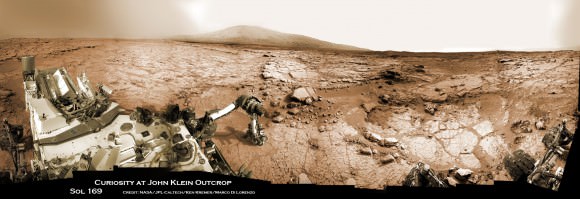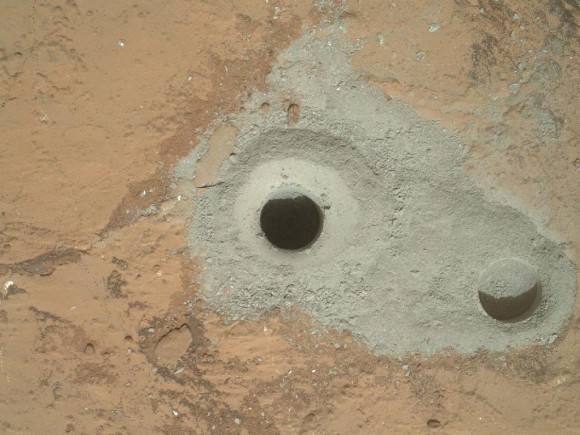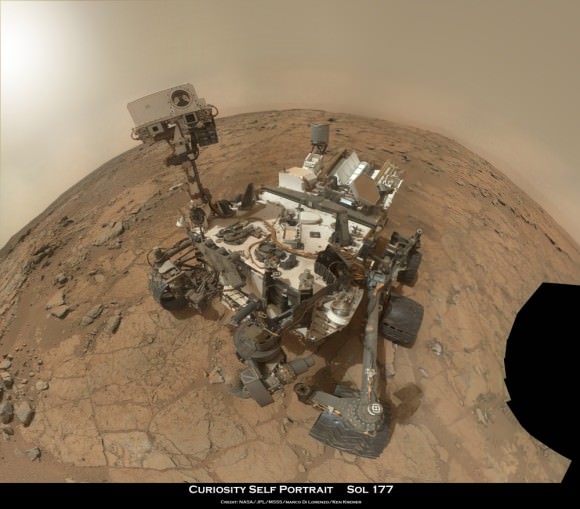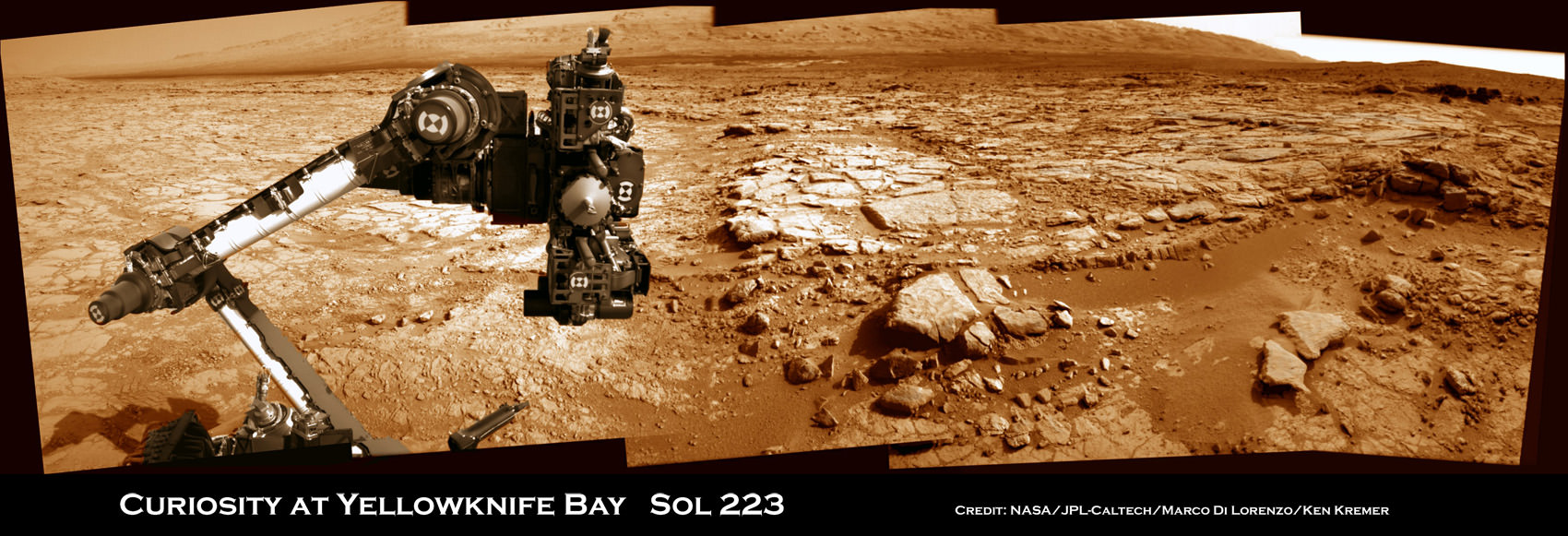Curiosity is back! After a multi-week hiatus forced by a computer memory glitch, NASA’s mega rover is back to full operation.
And the proof is crystal clear in the beautiful new panoramic view (above) snapped by Curiosity this weekend from Yellowknife Bay, showing the robot’s arm and drill elevated and aiming straight at you – raring to go and ready to feast on something deliciously Martian.
“That drill is hungry, looking for something tasty to eat, and ‘you’ (loaded with water and organics) are it,” I thought with a chuckle as Curiosity seeks additional habitats and ingredients friendly to life.
So my imaging partner Marco Di Lorenzo and I celebrated the great news by quickly creating the new panoramic mosaic assembled from images taken on Saturday, March 23, or Sol 223, by the robot’s navigation cameras. Our new Curiosity mosaic was first featured on Saturday at NBC News Cosmic Log by Alan Boyle – while I was hunting for Comet Pan-STARRS.
So the fact that Curiosity is again snapping images and transmitting fresh alien vistas and new science data is a relief to eagerly waiting scientists and engineers here on Earth.
Drilling goes to the heart of the mission. It was absolutely essential to the key finding of Curiosity’s Martian foray thus far – that Mars possesses an environment where alien microbes could once have thrived in the distant past when the Red Planet was warmer and wetter.

Curiosity has found widespread evidence for repeated episodes of flowing liquid water on the floor of her Gale Crater landing site – an essential prerequisite to life as we know it.
After coring and analyzing the first powder ever drilled from the interior of a Martian rock in February 2013, NASA’s Curiosity robot discovered some of the key chemical ingredients necessary to support life on early Mars billions of years ago.
Curiosity found that the fine-grained, sedimentary mudstone rock at the rovers current worksite inside the Yellowknife Bay basin possesses significant amounts of phyllosilicate clay minerals; indicating the flow of nearly neutral liquid water and a habitat friendly to the possible origin of simple Martian life forms eons ago.

The rovers 7 foot (2.1 meter) long robotic arm fed aspirin sized samples of the gray, pulverized powder into the miniaturized CheMin and SAM analytical instruments on Feb. 22 and 23, or Sols 195 and 196. The samples were analyzed on Sol 200 and then the rover experienced her first significant problems since landing on Aug. 5, 2012.
The Chemistry and Mineralogy (CheMin) instrument and Sample Analysis at Mars (SAM) instruments test the Martian soil and rock samples to determine their chemical composition and search for traces of organic molecules – the building blocks of life
No organics have been found thus far.
The rover’s science mission has been on hold for nearly a month since “a memory glitch on the A-side computer on Feb. 27, which prompted controllers to command a swap from the A-side computer to the B-side computer,” according to a NASA statement.
“That operator-commanded swap put Curiosity into safe mode for two days. The rover team restored the availability of the A-side as a backup and prepared the B-side to resume full operations.”
The memory issue may have been caused by a cosmic ray strike. The rover suffered another minor setback last week, briefly reentering ‘safe mode’. And in between, a solar storm forced the team to shut Curiosity down for a few more days.
All appears well now.
The next step is to reanalyze those 1st gray rock tailings to continue the hunt for traces of organic molecules.
But the next solar conjunction will interrupt communications starting around April 4 for several weeks. More on that shortly.
After conjunction, Curiosity will resume her drilling campaign
…………….
Learn more about Curiosity’s groundbreaking discoveries and NASA missions at Ken’s upcoming lecture presentations:
April 20/21 : “Curiosity and the Search for Life on Mars – (in 3-D)”. Plus Orion, SpaceX, Antares, the Space Shuttle and more! NEAF Astronomy Forum, Suffern, NY
April 28: “Curiosity and the Search for Life on Mars – (in 3-D)”. Washington Crossing State Park, Titusville, NJ, 130 PM



Dang… back on line just in time for the ‘black out’ due to the upcoming solar conjunction. How long? DZZZZ…. TOO long! A month? Eh? Dang double darn. Too bad we don’t have a co-orbiting data relay *.sat in place.. eh? None other to do the deed? I wish there was a way to get data back anyway, so the science could continue! No chance the STEREO mission could act as a relay? I know, I know… patience. But CURIOSITY killed the cat, and SATISFACTION brought him back… nine times! Here Kitty, kitty!
there are 3 orbiters at Mars- but its the same problem for all. read the details in my upcoming conjunction story. STEREO is not an option. glad you enjoyed the new montage !
Aside from the STEREO mission spacecraft, only the Mercury Messenger, ESA’s Venus Express orbiter or the now ’roundabout’ Japanese Akatsuki Venus mission could be anywhere near the right position(s) to relay data from Curiosity? IF they had that capability. The Ulysses mission is defunct, Deep Impact in hibernation(?), while New Horizon’s, Juno, DAWN, ISEE-3, Rosetta, Cassini, and ? are much too far away or otherwise tasked to be of any assistance. So… unless some unknown military or other spacecraft could be brought back to life, it’s all just ‘wishful thinking’ on my part… There’s that patience thing again!
’bout time :-).. Good luck!
Great mosaic .and nice report from you Ken !!!